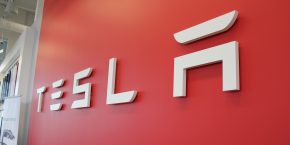
A new patent shows that Tesla designed its own semi-truck seat suspension for the Tesla Semi, which is equipped with a large centered seat.
Semi-trucks require especially comfortable seats since drivers spend long hours in them and discomfort over long periods of time can lead to some serious problems.
It’s the reason why many truck drivers end up swapping seats in their trucks for aftermarket products with better seat suspension and ergonomic features.
Tesla, which has been developing its own seats for its vehicles for a while now, has attempted to build its own seat for the Tesla Semi, its upcoming all-electric semi-truck, and today, we’ve learned that they have designed a new suspension system for it.
The automaker applied for a patent on the new seat suspension technology.
In the patent application, Tesla describes the tech:
“In one aspect, a vehicle seat includes: a suspension system having a multi post architecture, the suspension system including sleeves pivotally coupled to respective pairs of lift links, a first pair of lift links coupled to each other at a first pivot point, a second pair of lift links coupled to each other at a second pivot point; and a height adjustment system that is adjustable independently of the suspension system; wherein the suspension system is configured for passive suspension upon a passive component being coupled between the first and second pivot points, and for active suspension upon an active component being coupled between the first and second pivot points.
Implementations can include any or all of the following features. The multi-post architecture includes first through fourth posts, and the suspension system includes respective first through fourth sleeves for the first through fourth posts. The first and second sleeves are pivotally coupled to the first pair of lift links, and the third and fourth sleeves are pivotally coupled to the second pair of lift links. The vehicle seat has a front end and a rear end, the first pair of lift links is positioned toward the front end and the second pair of lift links is positioned toward the rear end. The first pair of lift links and the second pair of lift links are positioned side-by-side. At least one of the lift links has a Y-shape. A corresponding one of the first and second pivot points is located at a base of the Y-shape. The passive component comprises a coilover. The active component comprises an actuator. The height adjustment system comprises a four-bar linkage. The height adjustment system is positioned on top of the suspension system. The vehicle seat further includes a plate riding on the suspension system, the sleeves are coupled to the plate, and respective first ends of the pairs of lift links are pivotally coupled to the plate. The multi-post architecture includes posts coupled to a plate configured for fore/aft adjustment on a track.”
Here are a few drawings from Tesla’s patent application:
When Tesla unveiled the Tesla Semi in 2017, many noted a particularly novel interior design.
Tesla Semi is equipped with a centered seat with large computer screens located on each side:
While Tesla is working on a self-driving system for its passenger veicles, the company hasn’t been talking about self-driving for its planned semi truck.
Instead, it has been focusing on driver-assist features and comfort-improving features for the driver, like this new seat suspension.
Tesla Semi was supposed to be released in 2019, but it has been delayed.
Last month, Tesla said that it plans for electric truck production to start ‘with limited volumes’ in 2020.
FTC: We use income earning auto affiliate links. More.










Comments